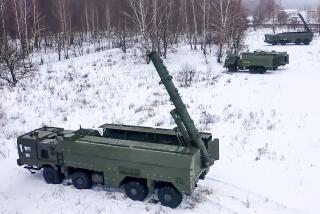Russia ‘Likely’ to Join NATO Nations in ’94 Exercises
- Share via
BRUSSELS — In an arrangement that could lead to full NATO membership, Russia is “quite likely” to join the United States and European nations in joint military exercises expected to begin as early as next year, U.S. and NATO officials said here Thursday.
U.S. Defense Secretary Les Aspin and NATO Secretary General Manfred Woerner, at the conclusion of two days of meetings in preparation for the North Atlantic Treaty Organization summit here next month, said they believe that Russia will abandon its opposition and decide to join the U.S.-sponsored Partnership for Peace program.
The program would pull together two dozen nations in military exercises to include training maneuvers, equipment sharing, search and rescue efforts, anti-terrorism activities, environmental cleanup and peacekeeping operations.
If Russia joins the program, as the officials predict, it will mark the first time that the country has agreed to extensive joint military activities, except for a bilateral arrangement announced earlier this year at the Pentagon for U.S.-Russian military maneuvers next summer.
Russian President Boris N. Yeltsin, in Brussels this week for European Community discussions on trade, gave encouraging signs to NATO officials that his nation is considering uniting with former Soviet Bloc countries in Eastern Europe and joining the Partnership for Peace. Under that plan, participating members could eventually become full members of NATO.
“It is quite likely that Russia might decide to join the Partnership for Peace,” Aspin said, “and might allocate some of its ground forces to this exercise, where they would jointly train with us.
Woerner, who met in a breakfast session with Yeltsin on Thursday, echoed Aspin’s optimism about Russia’s military training alongside Western nations aligned with NATO.
“My impression is that there is a chance that Russia will participate,” he said. “This alliance (NATO) is aiming for a new security architecture for Europe which would include Russia.”
In the two days of meetings, NATO defense ministers agreed to permit non-NATO nations that participate in the partnership program to join NATO in the future.
Prior to the two days of meetings here, Aspin and others had said that membership in the Partnership for Peace was not an automatic ticket for eventual full membership in NATO.
But this week, officials said that the new “partners” will make it into the North Atlantic defense organization once the program is running successfully.
*
Earlier, in an interview while flying from Washington to Brussels, Aspin predicted that some joint military operations will be starting soon.
“We plan to have some Partnership for Peace exercises under way before the end of 1994,” he said.
U.S. officials said the American share for the program will be about $7 million over the first two years, with much of the money going toward the building of Partnership for Peace offices in Mons, Belgium.
But Pentagon officials traveling here with Aspin warned that the United States will not pick up the costs for other countries that--because of depressed economies--may find themselves hard-pressed to pick up their share of the expenses.
Top NATO officials said that among the first Eastern European countries expected to join the program are Poland, Hungary and the Czech Republic.
More to Read
Sign up for Essential California
The most important California stories and recommendations in your inbox every morning.
You may occasionally receive promotional content from the Los Angeles Times.














